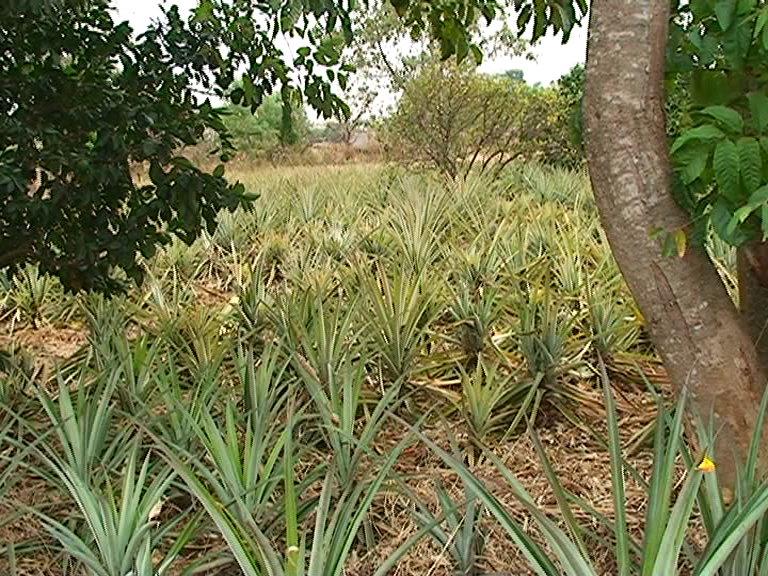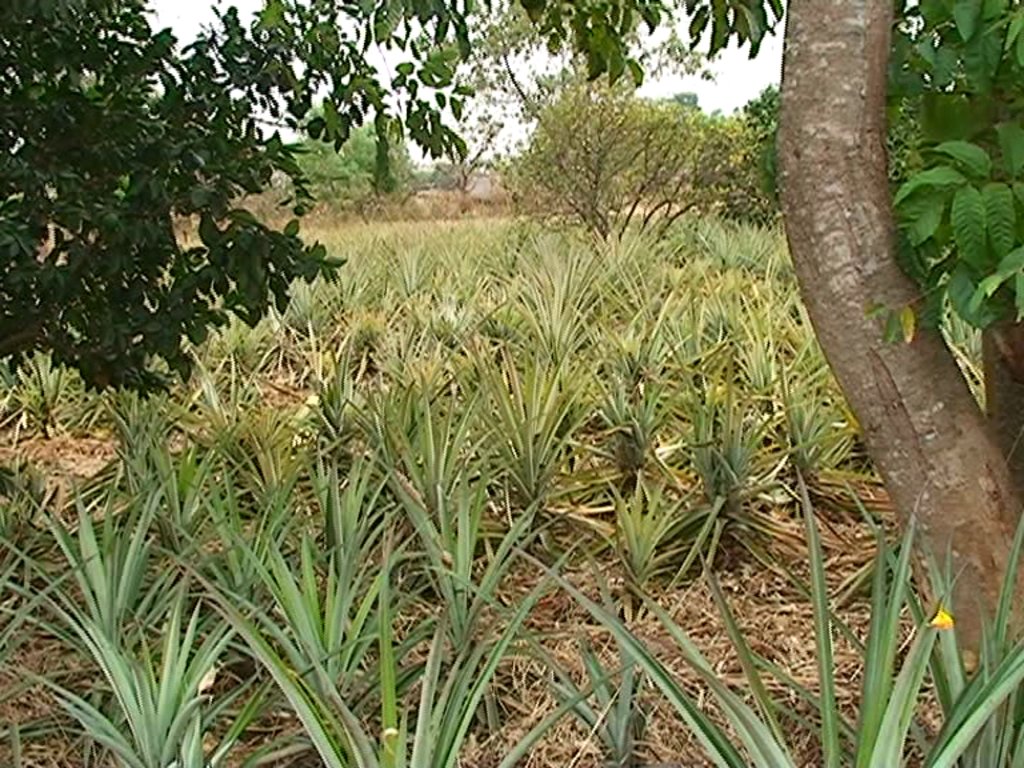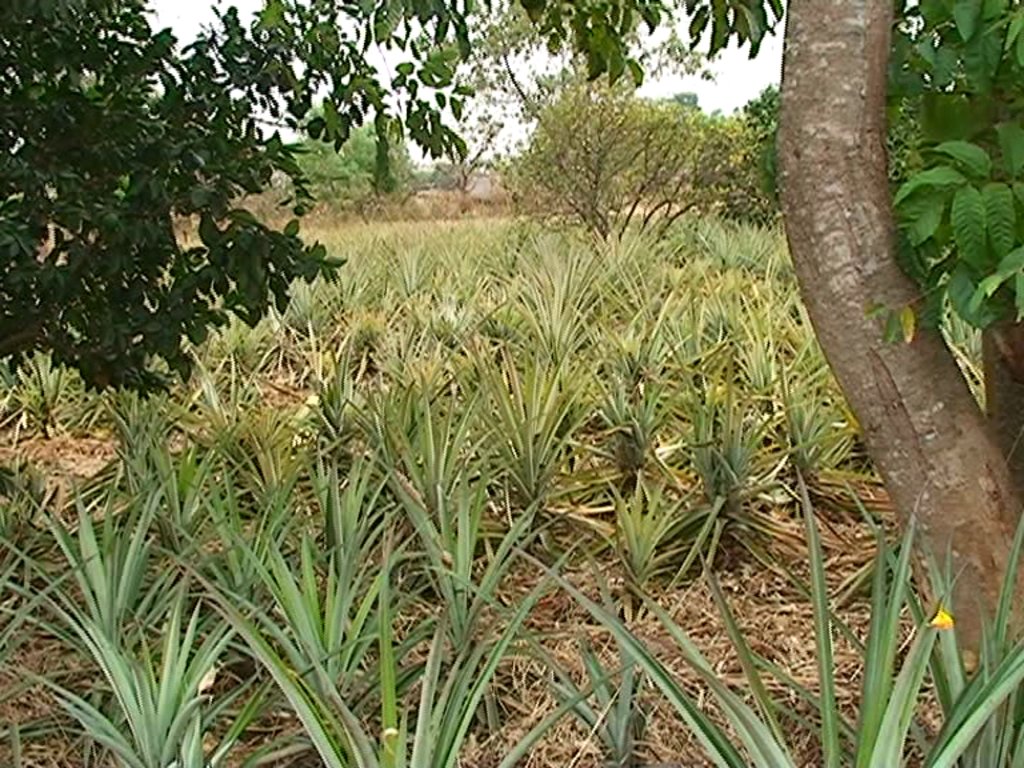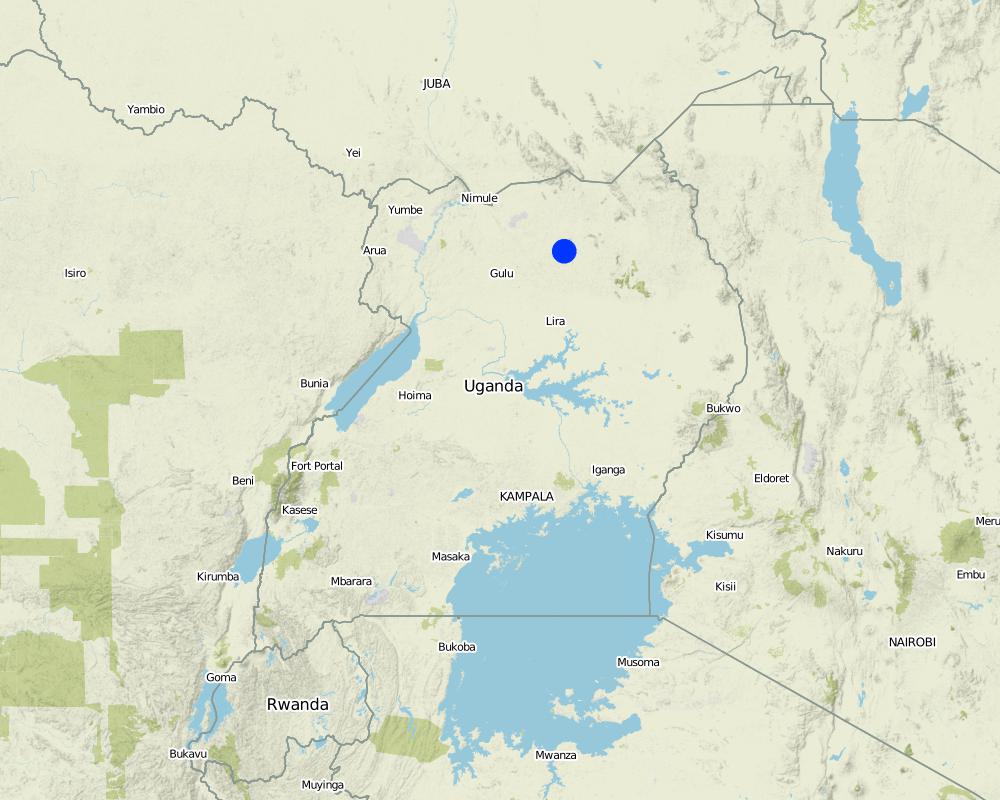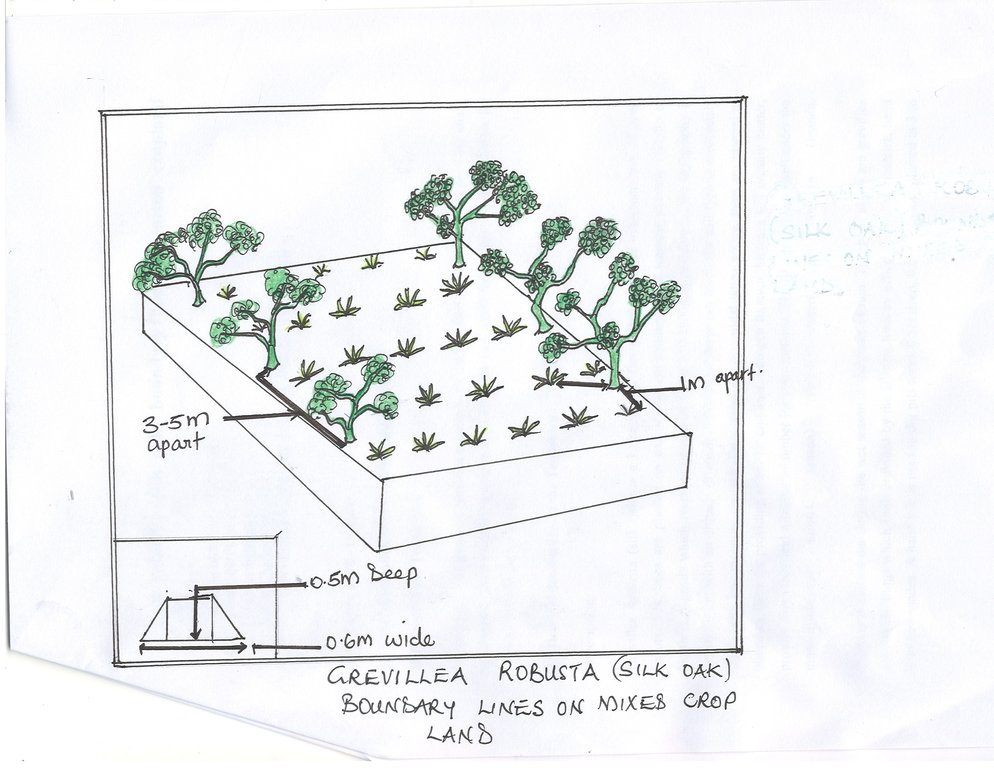Grevillea Robusta (Silk Oak) Boundary Lines on a Pineapple Cropland [乌干达]
- 创建:
- 更新:
- 编制者: betty adoch
- 编辑者: Kamugisha Rick Nelson, Bernard Fungo
- 审查者: John Stephen Tenywa, Nicole Harari, Renate Fleiner
Yen ipoto
technologies_2778 - 乌干达
查看章节
全部展开 全部收起1. 一般信息
1.2 参与该技术评估和文件编制的资源人员和机构的联系方式
关键资源人
土地使用者:
George Kilama
Pader District
Pader District, Laguti Sub county, Paibwor parish, Ojota Village.
乌干达
有助于对技术进行记录/评估的项目名称(如相关)
Scaling-up SLM practices by smallholder farmers (IFAD)有助于对技术进行记录/评估的机构名称(如相关)
Uganda Landcare Network (ULN) - 乌干达1.3 关于使用通过WOCAT记录的数据的条件
(现场)数据是什么时候汇编的?:
09/05/2017
编制者和关键资源人员接受有关使用通过WOCAT记录数据的条件。:
是
1.4 所述技术的可持续性声明
这里所描述的技术在土地退化方面是否存在问题,导致无法被认为是一种可持续的土地管理技术?:
否
注释:
The fast-growing Grevillea robusta (silk oak) provides several on-site advantages including acting as windbreak and increasing soil organic matter.
2. SLM技术的说明
2.1 技术简介
技术定义:
Leguminous, fast growing grevillea robusta (silk oak) planted as boundary lines provides shade to a pineapple cropland, increases soil organic matter, provides fuel wood for domestic use and timber for construction after 5-8 years.
2.2 技术的详细说明
说明:
Grevillea Robusta (silk oak) is a leguminous, fast growing and evergreen tree planted in a natural environment with tropical savanna climate of Northern Uganda which receives rainfall of about 750-1000 mm per annum, established on a generally flat slope with an altitude of about 1000 meters above sea level. The soil type is moderately fertile with low moisture content that favours tree growth. These trees are planted as boundary lines for providing shade on a pineapple cropland, nitrogen fixation, increasing soil organic matter, providing fuel wood and as a source of timber for construction after 5-8 years. The tree species generally grows well under the mono-modal (one rainfall season) rainfall pattern of Northern Uganda.
Planting is normally done during the wet season at the onset of rain in early April and the inputs required for establishing this technology include Grevillea Robusta seedlings majorly provided by the District forestry officers, farmyard manure, hand hoes and spades. A hand hoe is used to dig pits about 0.5 m deep, 0.6 m wide and 3 to 5 m apart and 1 meter away from the pineapple crop. Farmyard manure is added to the pit to fill a depth of about 0.3 m, a layer of top soil is added to 0.2 m depth and the seedling is planted on top. The rest of the pit is filled with soil and watered to improve soil moisture content. Bamboo canes can be woven around the seedlings to protect them from destruction by livestock. Grevillea Robusta grows fast when the boundary line is well established within two years. The pruned branches provide fuel wood for domestic use like cooking and within 5 to 8 years the trees are harvested for timber. Establishment costs for this technology are normally higher compared to maintenance costs especially for the purchase of Grevillea seedlings, manures, farm equipment like hand hoes and pangas. The technology is easily and spontaneously adopted by average smallholder farmers with less than 2 acres and is useful for providing shade to the pineapple crop thus increasing the yield. What is not liked about this technology is that it forms a big canopy that limits photosynthesis. To maintain this technology, the land user has to constantly prune whenever the canopy grows big.
2.3 技术照片
2.4 技术视频
注释、简短说明:
Grevillea trees along the pineapple field that are flourishing well.
日期:
9/52017
位置:
Pader District
摄影师的名字:
Betty Adoch
2.5 已应用该技术的、本评估所涵盖的国家/地区/地点
国家:
乌干达
区域/州/省:
Northern Uganda.
有关地点的进一步说明:
Pader Town Council
注释:
The map shows the land user's Grevillea Robuster garden which is used as wind break and provides shade to the pineapple garden.
Map
×2.6 实施日期
注明实施年份:
2012
如果不知道确切的年份,请说明大概的日期:
- 不到10年前(最近)
2.7 技术介绍
详细说明该技术是如何引入的:
- 通过土地使用者的创新
3. SLM技术的分类
3.1 该技术的主要目的
- 改良生产
- 保持/提高生物多样性
- 适应气候变化/极端天气及其影响
- 创造有益的经济影响
3.2 应用该技术的当前土地利用类型

混合(作物/放牧/树木),包括农林
- 农林业
主要产品/服务:
Grevillea trees act as windbreak, provide shade and increase soil organic matter for pineapple crops.
注释:
Fast growing woody leguminous trees provide shade, shelter from winds, soil fertility maintenance and timber production after 5-8 years.
如果由于技术的实施而导致土地用途发生变化,则在技术实施前说明土地利的用途。:
The land was used for growing vegetables.
3.3 有关土地利用的更多信息
该技术所应用土地的供水:
- 雨养
注释:
The grevillea trees rely on rain for growth.
每年的生长季节数:
- 1
具体说明:
The grevillea tree is a perennial crop
3.4 该技术所属的SLM组
- 农业林学
- 防风林/防护林带
- 土壤肥力综合管理
3.5 技术传播
具体说明该技术的分布:
- 均匀地分布在一个区域
如果该技术均匀地分布在一个区域上,请注明覆盖的大致区域。:
- < 0.1 平方千米(10 公顷)
注释:
The trees are planted along the side of the pineapple cropland
3.6 包含该技术的可持续土地管理措施

农艺措施
- A5:种子管理,改良品种

植物措施
- V1:乔木和灌木覆盖层
3.7 该技术强调的主要土地退化类型

土壤风蚀
- Et:表土流失
- Ed:风蚀风积
注释:
The trees act as wind breaks and also protect the soil against wind erosion.
3.8 防止、减少或恢复土地退化
具体数量名该技术与土地退化有关的目标:
- 防止土地退化
注释:
Grevillea trees prevent land degradation by soil erosion caused by wind and surface water runoff.
4. 技术规范、实施活动、投入和成本
4.1 该技术的技术图纸
4.2 技术规范/技术图纸说明
A hole is dug at a depth of 0.5 m, and 0.6 m wide. Farm yard manure added into the hole at a depth of 0.3 m and soil added to 0.2 m depth to fill up the hole in which tree seedlings are planted at a spacing of 3 or 5 meters apart since they do not form a huge canopy and 1 meter away from the pineapple crop.
4.3 有关投入和成本计算的一般信息
具体说明成本和投入是如何计算的:
- 每个技术区域
注明尺寸和面积单位:
7 acres
其它/国家货币(具体说明):
UGX
注明雇用劳工的每日平均工资成本:
3,000 shs
4.4 技术建立活动
| 活动 | 措施类型 | 时间 | |
|---|---|---|---|
| 1. | Land clearing | 管理 | Late March |
| 2. | Procurement of seedlings | 管理 | March |
| 3. | Planting | 管理 | Early April at onset of rainfall |
| 4. | Weeding | 管理 | May during wet season |
| 5. | Pruning | 管理 | November in wet season |
| 6. | Harvesting | 管理 | December during dry season for timber |
4.5 技术建立所需要的费用和投入
| 对投入进行具体说明 | 单位 | 数量 | 单位成本 | 每项投入的总成本 | 土地使用者承担的成本% | |
|---|---|---|---|---|---|---|
| 劳动力 | Hired labour | Day | 30.0 | 3000.0 | 90000.0 | 100.0 |
| 设备 | Hoe | pieces | 10.0 | 12000.0 | 120000.0 | 100.0 |
| 设备 | Panga | pieces | 5.0 | 10000.0 | 50000.0 | 100.0 |
| 植物材料 | Grevillea seedlings | pieces | 500.0 | 100.0 | 50000.0 | 100.0 |
| 肥料和杀菌剂 | Manure | Kgs | 20.0 | 5000.0 | 100000.0 | 100.0 |
| 施工材料 | Bamboo reeds | pieces | 100.0 | 1000.0 | 100000.0 | 100.0 |
| 技术建立所需总成本 | 510000.0 | |||||
4.6 维护/经常性活动
| 活动 | 措施类型 | 时间/频率 | |
|---|---|---|---|
| 1. | Pruning | 管理 | November |
| 2. | Weeding | 管理 | May |
4.7 维护/经常性活动所需要的费用和投入(每年)
| 对投入进行具体说明 | 单位 | 数量 | 单位成本 | 每项投入的总成本 | 土地使用者承担的成本% | |
|---|---|---|---|---|---|---|
| 劳动力 | hired labour | days | 5.0 | 3000.0 | 15000.0 | 100.0 |
| 设备 | hoes | pieces | 10.0 | 12000.0 | 120000.0 | 100.0 |
| 设备 | pangas | pieces | 5.0 | 10000.0 | 50000.0 | 100.0 |
| 技术维护所需总成本 | 185000.0 | |||||
注释:
A good technology that is affordable for any land user to implement because of its on-site benefits like improving soil organic matter and harvesting fuel wood for cooking.
4.8 影响成本的最重要因素
描述影响成本的最决定性因素:
The Grevillea seedlings were distributed at a cost from the District. There is also high cost of hiring labour. However, family members can also help in maintaining the technology.
5. 自然和人文环境
5.1 气候
年降雨量
- < 250毫米
- 251-500毫米
- 501-750毫米
- 751-1,000毫米
- 1,001-1,500毫米
- 1,501-2,000毫米
- 2,001-3,000毫米
- 3,001-4,000毫米
- > 4,000毫米
指定年平均降雨量(若已知),单位为mm:
1000.00
有关降雨的规范/注释:
Moderate rain from April to October which supports the growth of the trees.
注明所考虑的参考气象站名称:
kitgum weather station
农业气候带
- 半湿润
Tropical savanna climate
5.2 地形
平均坡度:
- 水平(0-2%)
- 缓降(3-5%)
- 平缓(6-10%)
- 滚坡(11-15%)
- 崎岖(16-30%)
- 陡峭(31-60%)
- 非常陡峭(>60%)
地形:
- 高原/平原
- 山脊
- 山坡
- 山地斜坡
- 麓坡
- 谷底
垂直分布带:
- 0-100 m a.s.l.
- 101-500 m a.s.l.
- 501-1,000 m a.s.l.
- 1,001-1,500 m a.s.l.
- 1,501-2,000 m a.s.l.
- 2,001-2,500 m a.s.l.
- 2,501-3,000 m a.s.l.
- 3,001-4,000 m a.s.l.
- > 4,000 m a.s.l.
关于地形的注释和进一步规范:
The land is generally flat that supports the growth of the grevillea trees.
5.3 土壤
平均土层深度:
- 非常浅(0-20厘米)
- 浅(21-50厘米)
- 中等深度(51-80厘米)
- 深(81-120厘米)
- 非常深(> 120厘米)
土壤质地(表土):
- 中粒(壤土、粉土)
土壤质地(地表以下> 20厘米):
- 中粒(壤土、粉土)
表土有机质:
- 高(>3%)
5.4 水资源可用性和质量
地下水位表:
5-50米
地表水的可用性:
中等
水质(未处理):
良好饮用水
水的盐度有问题吗?:
否
该区域正在发生洪水吗?:
否
5.5 生物多样性
物种多样性:
- 高
栖息地多样性:
- 高
5.6 应用该技术的土地使用者的特征
定栖或游牧:
- 定栖的
生产系统的市场定位:
- 混合(生计/商业
非农收入:
- 低于全部收入的10%
相对财富水平:
- 丰富
个人或集体:
- 个人/家庭
机械化水平:
- 手工作业
性别:
- 女人
- 男人
土地使用者的年龄:
- 青年人
说明土地使用者的其他有关特征:
A subsistence farmer
5.7 应用该技术的土地使用者拥有或租用的平均土地面积
- < 0.5 公顷
- 0.5-1 公顷
- 1-2 公顷
- 2-5公顷
- 5-15公顷
- 15-50公顷
- 50-100公顷
- 100-500公顷
- 500-1,000公顷
- 1,000-10,000公顷
- > 10,000公顷
这被认为是小规模、中规模还是大规模的(参照当地实际情况)?:
- 中等规模的
5.8 土地所有权、土地使用权和水使用权
土地所有权:
- 个人,未命名
土地使用权:
- 个人
用水权:
- 自由进入(无组织)
5.9 进入服务和基础设施的通道
健康:
- 贫瘠
- 适度的
- 好
教育:
- 贫瘠
- 适度的
- 好
技术援助:
- 贫瘠
- 适度的
- 好
就业(例如非农):
- 贫瘠
- 适度的
- 好
市场:
- 贫瘠
- 适度的
- 好
能源:
- 贫瘠
- 适度的
- 好
道路和交通:
- 贫瘠
- 适度的
- 好
饮用水和卫生设施:
- 贫瘠
- 适度的
- 好
金融服务:
- 贫瘠
- 适度的
- 好
6. 影响和结论性说明
6.1 该技术的现场影响
社会经济效应
生产
作物生产
SLM之前的数量:
low
SLM之后的数量:
high
木材生产
SLM之前的数量:
low
SLM之后的数量:
high
土地管理
SLM之前的数量:
low
SLM之后的数量:
high
能源生产
SLM之前的数量:
low
SLM之后的数量:
high
收入和成本
农业收入
SLM之前的数量:
low
SLM之后的数量:
high
收入来源的多样性
SLM之前的数量:
low
SLM之后的数量:
high
社会文化影响
SLM/土地退化知识
SLM之前的数量:
low
SLM之后的数量:
high
生态影响
土壤
土壤水分
SLM之前的数量:
low
SLM之后的数量:
high
土壤覆盖层
SLM之前的数量:
low
SLM之后的数量:
high
土壤流失
SLM之前的数量:
high
SLM之后的数量:
low
注释/具体说明:
the trees protect the soil from erosion
土壤有机物/地下C
SLM之前的数量:
low
SLM之后的数量:
high
生物多样性:植被、动物
植被覆盖
SLM之前的数量:
low
SLM之后的数量:
high
生物量/地上C
SLM之前的数量:
low
SLM之后的数量:
high
植物多样性
SLM之前的数量:
low
SLM之后的数量:
high
有益物种
SLM之前的数量:
low
SLM之后的数量:
high
栖息地多样性
SLM之前的数量:
low
SLM之后的数量:
high
减少气候和灾害风险
风速
SLM之前的数量:
high
SLM之后的数量:
low
注释/具体说明:
trees protect the pineapple garden from strong wind
6.2 该技术的场外影响已经显现
缓冲/过滤能力
SLM之前的数量:
Low
SLM之后的数量:
High
注释/具体说明:
Grevillea trees act as windbreak on a pineapple field
风力搬运沉积物
SLM之前的数量:
high
SLM之后的数量:
low
有关影响评估的意见:
The technology promotes biodiversity.
6.3 技术对渐变气候以及与气候相关的极端情况/灾害的暴露和敏感性(土地使用者认为的极端情况/灾害)
渐变气候
渐变气候
| 季节 | 气候变化/极端天气的类型 | 该技术是如何应对的? | |
|---|---|---|---|
| 年温度 | 增加 | 适度 | |
| 季节性温度 | 湿季/雨季 | 增加 | 适度 |
| 年降雨量 | 减少 | 适度 | |
| 季雨量 | 湿季/雨季 | 减少 | 适度 |
气候有关的极端情况(灾害)
气象灾害
| 该技术是如何应对的? | |
|---|---|
| 局地暴雨 | 适度 |
| 局地雷暴 | 适度 |
| 局地雹灾 | 适度 |
气候灾害
| 该技术是如何应对的? | |
|---|---|
| 干旱 | 适度 |
| 森林火灾 | 适度 |
6.4 成本效益分析
技术收益与技术建立成本相比如何(从土地使用者的角度看)?
短期回报:
稍微积极
长期回报:
积极
技术收益与技术维护成本/经常性成本相比如何(从土地使用者的角度看)?
短期回报:
稍微积极
长期回报:
非常积极
6.5 技术采用
- 1-10%
在所有采用这项技术的人当中,有多少人是自发地采用该技术,即未获得任何物质奖励/付款?:
- 90-100%
注释:
spontaneous adoption by other land users
6.6 适应
最近是否对该技术进行了修改以适应不断变化的条件?:
是
若是,说明它适应了哪些变化的条件:
- 气候变化/极端气候
具体说明技术的适应性(设计、材料/品种等):
The grevillea robusta trees increase soil water retention after heavy rainfall episodes, and organic matter.
6.7 该技术的优点/长处/机会
| 土地使用者眼中的长处/优势/机会 |
|---|
| Grevillea trees when mature provide timber for construction. |
| Grevillea tree branches when pruned supply fuel wood. |
| The dry tree leaves decompose and provide manure for the garden. |
| 编制者或其他关键资源人员认为的长处/优势/机会 |
|---|
| Grevillea robusta provides many soil conservation benefits like nitrogen fixing and soil moisture retention among them. |
| Young shoots from grevillea robusta provide animal fodder. |
| The trees helps modify the microclimate. |
6.8 技术的弱点/缺点/风险及其克服方法
| 土地使用者认为的弱点/缺点/风险 | 如何克服它们? |
|---|---|
| Trees take up some of the cropland that should have been used to grow other crops. | Agroforestry |
| Labour intensive in terms of pruning trees. | Family members to provide labour |
| 编制者或其他关键资源人员认为的弱点/缺点/风险 | 如何克服它们? |
|---|---|
| Grevillea provides shade to pineapple crops that obstructs the photosynthesis process. | Plant grevillea at a distance from the plant |
7. 参考和链接
7.1 信息的方法/来源
- 实地考察、实地调查
1
- 与土地使用者的访谈
1
- 与SLM专业人员/专家的访谈
1
7.3 链接到网络上可用的相关信息
URL:
https://www.gardenia.net/plant/Grevillea-robusta-Silky-Oak
链接和模块
全部展开 全部收起链接
无链接
模块
无模块


